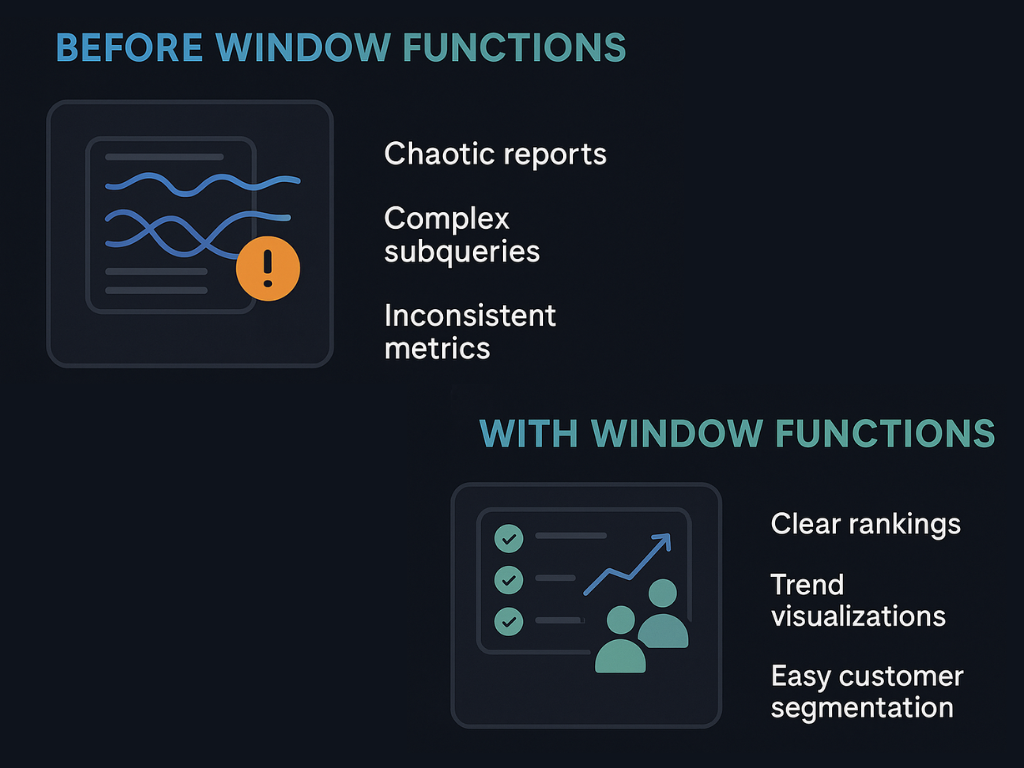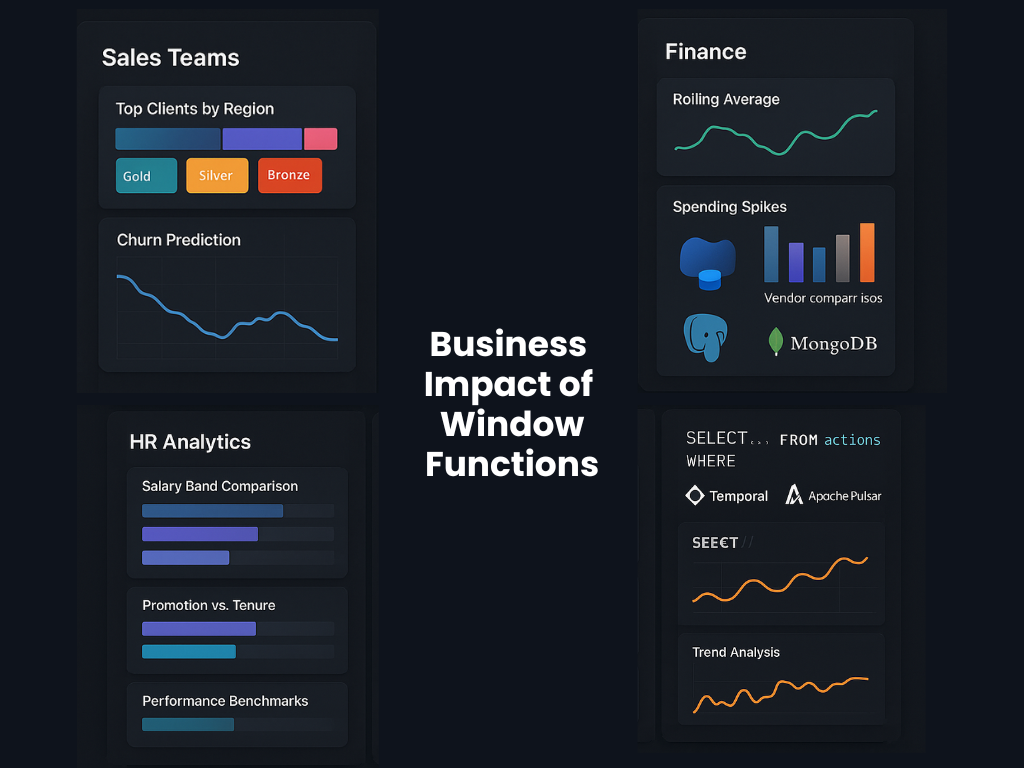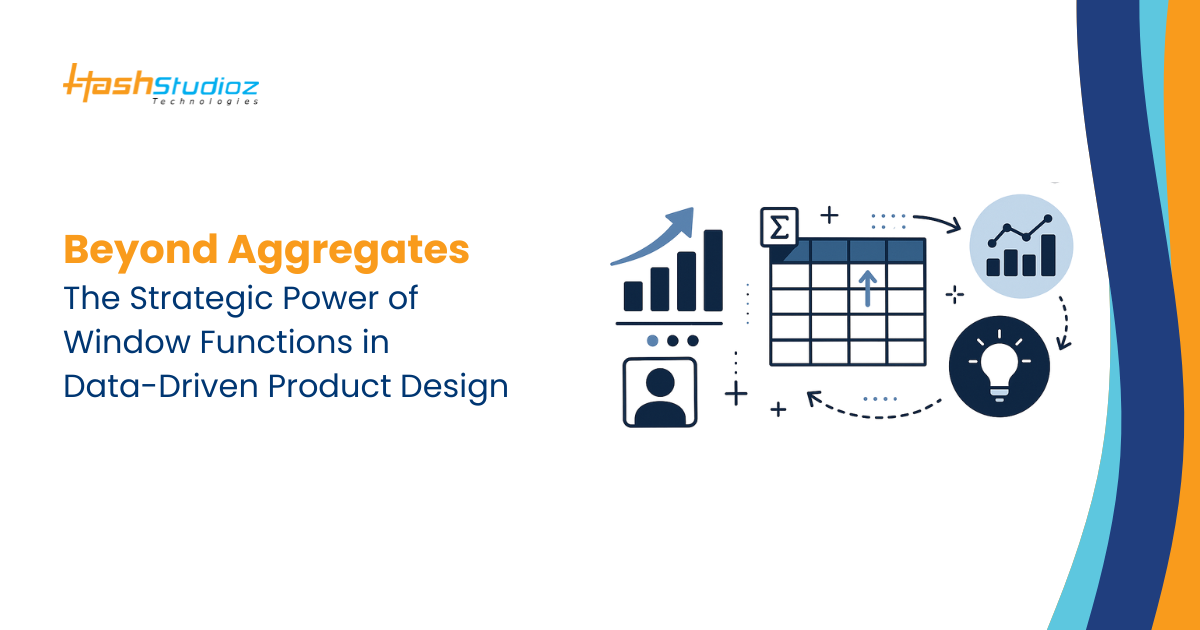In the evolving landscape of data-powered systems, success is often measured not by how much data you have, but how intelligently you use it. Whether you’re personalizing user experiences, optimizing operations, or forecasting trends—timely and contextual insights are the cornerstone of innovation. And that’s where the window functions quietly yet powerfully steps in.
This isn’t a lesson in SQL syntax. This is a deep dive into why window functions are becoming a core engine behind modern decision-making systems across industries—from finance to e-commerce to healthcare—and how they enable better product design and business strategy.
Table of Contents
Why Traditional Aggregates Fall Short
Imagine running a retail analytics platform. You want to find the top 5% of customers in each city based on spending. A traditional GROUP BY and MAX() aggregation will give you the highest spender per group—but what about the second highest? Or customers who are just slightly below the top?
The problem with traditional aggregate queries is that they collapse data. You lose context—where a particular row stands relative to others. And context is exactly what modern data systems need.
In contrast, window functions let you retain row-level details while computing complex, comparative insights.

What Are Window Functions (Conceptually)?
Think of a “window” as a dynamic lens over a subset of your data. Instead of squashing all rows into one result, you slide a frame across your dataset—be it over all rows, or partitioned by region, department, customer, or day—and calculate statistics within that frame.
This allows you to:
- Rank employees within departments
- Track a customer’s progress relative to others
- Monitor trends over rolling time intervals
- Detect behavioral anomalies without flattening the dataset
The key value is that you’re not just analyzing isolated rows—you’re analyzing them in context.
Product-Driven Use Cases: Making Better Experiences
Let’s go from abstract to concrete. Here are ways companies leverage window functions to build better products:
1. Personalized Leaderboards in Gaming Apps
Games often show real-time leaderboards based on user score. But players don’t care about being ranked 31,529th globally. They care how close they are to the top in their region, or how they’re performing compared to friends.
Window functions like RANK() or PERCENT_RANK() enable localized, scoped ranking without writing complex application logic. This leads to better engagement by showing players relevant comparisons.
2. Contextual Health Insights
In healthcare analytics platforms, understanding how a patient’s blood pressure trends over time relative to others in the same demographic group is crucial. Using window functions like LAG() and AVG() OVER, systems can:
- Flag anomalies in real-time
- Show percentile-based health indicators
- Send contextual alerts like “your cholesterol is higher than 90% of others in your age group”
The result? Proactive care instead of reactive treatment.
3. Smart Pricing Engines in E-commerce
Modern e-commerce doesn’t just match price—it tracks how pricing ranks over time against competitors and categories. Window functions allow platforms to:
- Detect the top-selling products per category per week
- Adjust promotions based on the historical performance trend
- Compare a vendor’s pricing against the median of similar products
Every pricing decision becomes a data-backed, competitive move.
Business Impact: Going Beyond Reporting
Window functions aren’t just for analytics teams. They directly empower strategic decisions across departments:
1. Sales Teams: Tiered Customer Insights
Want to know who your top 10% clients are, per region, per quarter? Or identify customers whose current orders are 20% below their own average? Window functions enable:
- Customer churn prediction
- Revenue concentration analysis
- Tier-based marketing campaigns (gold, silver, bronze)
This allows sales and marketing to focus their energy where it counts.
2. Finance: Trend-Aware Forecasting
Accounting teams can use window functions to compute rolling averages and detect unusual financial patterns. For example:
- A sudden spike in spending over the last 3 months
- Identifying vendors who’ve increased costs by more than 15% compared to their historical rates
It replaces crude threshold-based rules with dynamic, data-aware checks.

3. HR Analytics: Fairness and Trends
With RANK(), NTILE(), or FIRST_VALUE(), HR teams can:
- Evaluate salary bands and highlight outliers
- Compare promotions vs. tenure in departments
- Benchmark performance scores across similar roles
This data informs equity, performance, and retention strategies—not just reports.
Impact in IT and Data Engineering
For developers and data engineers, window functions mean:
- Cleaner code: You shift complex logic from application layers into the query layer
- Performance boosts: Many engines (like PostgreSQL, Snowflake, BigQuery) optimize window functions far better than custom loops
- Composable logic: Combine multiple window functions to build cascading insights (e.g., RANK() + LAG() + AVG())
As pipelines scale and real-time insights become a necessity, window functions are foundational tools, not advanced extras.
Real-World Scenarios
Here are real-world product examples driven by window functions:
- LinkedIn uses them to show percentile rankings of your profile views.
- Spotify uses them to analyze your music habits against your history and group trends.
- Uber detects driver performance by comparing their metrics within city-level windows.
- YouTube may use similar logic to rank comments or trending content in localized regions.
These aren’t BI dashboards. These are user-facing features. Window functions have moved from the backroom to the front stage.
Looking Ahead
In a world drowning in data, context is currency. The ability to say not just “what happened” but “how that compares to what usually happens”—in real-time, per user, per event—is gold.
Window functions give you that context.
They are not just an SQL feature—they are a mindset. A way to think in frames and comparisons. A bridge between raw data and personalized, relevant insights.
As product teams, data engineers, and business leaders embrace this mindset, window functions will continue shaping the future of intelligent systems—quietly, but profoundly.

Final Thought
If you’re building data-driven products and you’re not leveraging window functions, you’re likely writing more code than you need—and delivering less insight than you could. Traditional methods may get you part of the way, but they often involve complex joins, subqueries, or expensive application-side logic to achieve what a single, well-crafted window function can do natively within your database engine.
In a fast-moving, data-hungry world, businesses can no longer afford to treat analytics as a backend luxury. The difference between a good product and a great one often lies in how well it understands and adapts to individual user behaviors, market fluctuations, and operational trends—all in context. Window functions aren’t just about writing smarter SQL—they’re about building smarter systems.
By embedding comparative, dynamic insights directly into your queries, you empower your product to think and respond like a real-time analyst. Whether you’re personalizing a user journey, optimizing a workflow, or driving predictive intelligence, window functions act as the silent engines behind the scenes, transforming rows into relationships and metrics into meaning.
Don’t just use data. Understand it—contextually, efficiently, and intelligently. That’s the real promise of window functions.

